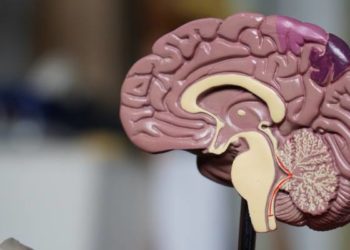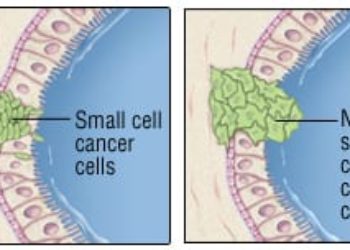2 Minute Medicine Rewind July 26, 2021
1. A daily remote symptom monitoring system reduced both the physical and psychological burden of chemotherapy side effects across six chemotherapy cycles, compared to standard care.
Evidence Rating Level: 1 (Excellent)
Individuals undergoing chemotherapy can experience numerous side effects from their treatments. However, patients are tasked with determining whether their symptoms are severe enough to report to their doctors. This can lead to underreporting of adverse side effects, which can have consequences for patient safety, quality of life, and health costs. Remote monitoring is a proposed solution, as patient’s symptoms can be communicated to doctors as quickly as possible. The current randomized controlled trial evaluated the Advanced Symptom Management System (ASyMS), a remote monitoring system for chemotherapy, on whether it improved symptom burden for patients with breast cancer, colorectal cancer, Hodgkin’s disease, and non-Hodgkin’s lymphoma. The ASyMS consisted of a temperature check and questionnaires completed daily and whenever the patient is unwell. The questionnaire asks about 10 side effects, such as gastrointestinal symptoms, pain, and signs of infection. This data informs alerts that are sent to clinicians, who can follow-up with patients by phone when there are red flags. Recruited from 12 cancer centres across Europe, there were 415 patients in the ASyMS group and 414 in the standard care group, with individuals participating for up to six chemotherapy cycles. The primary outcome was physical and psychological symptom burden, measured with the Memorial Symptom Assessment Scale (MSAS). Overall, there was a decrease in symptoms (compared to pre-chemotherapy) over all six cycles in the ASyMS group. In the standard care group, there was an increase in symptoms in cycle 1, with symptoms diminishing gradually over the next five cycles. The difference in least squares means was -0.15 in favour of the ASyMS group (95% CI -0.19 to -0.12, p < 0.001). Other sub-domains of the MSAS also demonstrated improvements in the ASyMS group, such as the global distress index (difference in LS means of -0.21, 95% CI -0.27 to -0.16, p < 0.001), psychological score (difference -0.16, 95% CI -0.23 to -0.10, p < 0.001), and physical score (difference -0.21, 95% CI -0.26 to -0.17, p < 0.001). The global distress and psychological scores showed decreased symptoms in both groups (with the ASyMS group showing larger decreases) whereas the physical score showed increased symptoms in both groups (with the ASyMS group showing smaller increases). In conclusion, the ASyMS was an effective remote monitoring solution that decreased the burden of symptoms for patients undergoing chemotherapy.
1. For mild traumatic brain injury, various pathological findings were associated with different prognostic implications for mild traumatic brain injury up to 1 year.
Evidence Rating Level: 2 (Good)
An acute traumatic brain injury (TBI) is characterized by various forms of intracranial hemorrhage observed on a computed tomography (CT) scan. The association between different findings on CT and prognosis has been researched extensively for moderate and severe TBI, but not for mild TBI. This is because impairments from mild TBI tend to be more subtle, thereby requiring larger study populations to make prognostic determinations. The current longitudinal study examined mTBI patients at 18 American Level 1 trauma centres at 2 weeks, 3, 6, and 12 months after injury. These results were then externally validated with another longitudinal cohort of 2594 mTBI patients from 55 European trauma centres. Patients with mTBI were those with Glasgow Coma Scale scores of 13 to 15 upon presentation to the emergency department. The primary outcome was the Glasgow Outcome Scale-Extended (GOSE) score, an 8-point scale measuring global function after TBI: Incomplete recovery was defined as a GOSE score less than 8, and greater degrees of unfavourable outcomes was defined as a GOSE score less than 5. Three categories of CT findings emerged from cluster analysis: The first category consisted of contusion, subarachnoid hemorrhage (SAH), and subdural hematoma (SDH); the second consisted of intraventricular and petechial hemorrhage; and the third consisted of epidural hematoma. The results showed that the first cluster was strongly associated with incomplete recovery from 2 weeks to 12 months, with odds ratios ranging from 1.67 at 6 months (95% CI 128-2.17) to 2.22 at 2 weeks (95% CI 1.61-3.06). This cluster was also associated with greater degrees of unfavourable outcomes from 2 weeks to 12 months (OR 2.14, 95% CI 1.48-3.10 at 2 weeks; OR 3.23, 95% CI 1.59-6.58 at 12 months). The second cluster of CT features was significantly associated with unfavourable outcomes at 3, 6, and 12 months (OR 2.37, 95% CI 1.14-4.92 at 3 months; OR 3.47, 95% CI 1.66-7.26 at 12 months). Lastly, epidural hematoma was associated with incomplete recovery at the earlier time points (OR 3.08, 95% CI 1.27-7.49, p = 0.01 at 2 weeks; OR 2.33, 95% CI 1.28-4.24, p = 0.006 at 3 months). Overall, various pathological features on CT were associated with different prognostic outcomes for mild TBI, with recovery being impacted anywhere from 2 weeks to 12 months after injury.
Suicide incidence and risk among patients with head and neck cancer in rural vs urban areas
1. Survivors of head and neck cancer (HNC) from rural American counties had double the rate of suicides compared to HNC survivors from metropolitan and urban counties.
Evidence Rating Level: 2 (Good)
Suicide has been in the top 10 leading causes of death in the United States since 2008. As well, the suicide rate is twice greater among cancer survivors, and 4 times as great with head and neck cancer (HNC) survivors. There is currently not much information on how living in an urban or rural setting may affect suicide rates for HNC survivors. This data is imperative due to the fact that cancer survival is lower in rural areas, and there is less access to cancer and mental health services rurally. The current study compared the incidence of suicide across metropolitan, urban, and rural counties for 134,510 HNC patients in the USA, from the years 2000 to 2016. Rural counties were defined as those with a population of less than 2500 people. The study found that In metropolitan counties, there were 59.2 suicides per 100,000 person-years; in urban counties, there were 64.0 per 100,000 person-years; and in rural counties, there were 126.7 per 100,000 person-years. Through cumulative incidence analyses, rural patients had the greatest incidence of suicide. Compared to those in rural counties, urban and metropolitan counties had around 50% the suicide risk (hazards ratio 0.51, 95% CI 0.28-0.92 and HR 0.48, 95% CI 0.28-0.82 respectively). Overall, this study underlies the need for increased access to mental health services, especially for HNC survivors.
Breastfeeding in the first days of life is associated with lower blood pressure at 3 years of age
1. Breastfeeding was correlated with lower blood pressures for children at 3 years old, regardless of duration, including breastfeeding for just the first few days of life.
Evidence Rating Level: 2 (Good)
Rates of hypertension are increasing globally, and research has shown that some risk factors for high blood pressure may stem from infancy and childhood, such as preterm birth and early nutrition. Although breast milk contains nutrients that can bolster cardiovascular health in early life, the evidence is conflicting on whether breastfeeding is associated with hypertension in children. This may be due to varying definitions of breastfeeding, with the importance of duration and timing of breastfeeding not being fully understood. The current prospective study based in Canada examined the link between early limited breastfeeding (in the first few days of life) with blood pressure at 3 years of age. The study population consisted of 2382 children born as singletons, at greater than 34 weeks gestation. Breastfeeding information in the hospital was collected by nursing staff, whereas breastfeeding later on was gathered from questionnaires done at 3, 6, 12, 18, and 24 months. Overall, the study found that 2333 (98%) of children were ever breastfed, and 98 (4%) were only breastfed in the first few days after birth. 62% were breastfed for 3 months, and 78% were breastfed for 6 months or longer. The mean (±SD) blood pressure was 99 (±9) mmHg systolic and 57 (±7) mmHg diastolic, corresponding to the 70th and 77th percentiles respectively. Children who were ever breastfed had lower systolic blood pressures than those who were never breastfed (-3.65 mmHg, 95% CI -6.23 to -1.07). Although the diastolic blood pressures were also lower, the difference was not statistically significant. Even among children with just early limited breastfeeding, the difference in systolic and diastolic blood pressures were significant (-4.24 mmHg, 95% CI -7.45 to -1.04 systolic; -2.62 mmHg,95% CI-4.87 to -0.37 diastolic). Furthermore, factors such as sex, maternal ethnicity, birth weight, and child BMI did not confound this association. Therefore, this study demonstrated that even early limited breastfeeding was significantly associated with a reduction in blood pressure at 3 years of age, regardless of the duration of breastfeeding.
1. Following emergency general surgery procedures, frail patients had poorer clinical outcomes such as higher mortality, non-home discharge rates, and hospital readmissions, as well as greater hospital costs.
Evidence Rating Level: 2 (Good)
Emergency general surgeries (EGS) carry greater risk of mortality and other poorer clinical outcomes, due to the involvement of patients in critical states, such as organ dysfunction and compromised physiology. Although old age has been found to unreliably predict poorer postsurgical outcomes, frailty is a potential predictor. Frailty refers to patients with many chronic conditions who cannot tolerate physiologic stresses. The current retrospective study evaluated the association of frailty with clinical outcomes such as mortality length of stay, hospital costs, non-home discharge rates, and readmissions, following EGS operations. The study population was taken from the nationwide Readmissions Database (NRD), which accounts for 58% of all hospitalizations in the USA. Patients were included for EGS procedures, such as large and small bowel resection, perforated ulcer repair, cholecystectomy, and appendectomy. The Johns Hopkins frailty index was used to separate patients into frail and nonfrail groups: Frailty diagnoses included dementia, vision impairment, weight loss, poverty, and lack of access to healthcare. Overall, the study population consisted of 655,817 patients, of which 78,093 (11.9%) were categorized as frail. This cohort was older, with 65.0% being older than 65 years, compared to 32.4% in the nonfrail cohort. The study found that the frail cohort had higher rates of mortality, non-home discharge, hospital readmission, and hospital costs. Perforated ulcer repair and large bowel resection were the procedures with the greatest differences in mortality rate. With regards to mortality rate, the greatest difference was found for perforated ulcer repair (8.3%, 95% CI 7.1-10.4%). For non-home discharge, perforated ulcer repair and large bowel resection exhibited the largest differences. And for hospital costs, perforated ulcer repair showed the greatest differences ($24,600, 95% CI $22,300-26,900). Therefore, this study found that frail patients had poorer clinical outcomes and increased use of medical resources after EGS, which underlies the need for using frailty assessments to identify patients, to provide optimal support postoperatively.
Image: PD
©2021 2 Minute Medicine, Inc. All rights reserved. No works may be reproduced without expressed written consent from 2 Minute Medicine, Inc. Inquire about licensing here. No article should be construed as medical advice and is not intended as such by the authors or by 2 Minute Medicine, Inc.









